Solar eclipse of July 9, 1945
| Solar eclipse of July 9, 1945 | |
|---|---|
 Map | |
| Type of eclipse | |
| Nature | Total |
| Gamma | 0.7356 |
| Magnitude | 1.018 |
| Maximum eclipse | |
| Duration | 75 sec (1 m 15 s) |
| Coordinates | 70°00′N 17°12′W / 70°N 17.2°W |
| Max. width of band | 92 km (57 mi) |
| Times (UTC) | |
| Greatest eclipse | 13:27:46 |
| References | |
| Saros | 145 (18 of 77) |
| Catalog # (SE5000) | 9387 |
A total solar eclipse occurred on July 9, 1945. A solar eclipse occurs when the Moon passes between Earth and the Sun, thereby totally or partly obscuring the image of the Sun for a viewer on Earth. A total solar eclipse occurs when the Moon's apparent diameter is larger than the Sun's, blocking all direct sunlight, turning day into darkness. Totality occurs in a narrow path across Earth's surface, with the partial solar eclipse visible over a surrounding region thousands of kilometres wide. The path of totality crossed northern North America, across Greenland and into Scandinavia, western Soviet, and central Asia.
Related eclipses
Solar eclipses 1942-1946
Each member in a semester series of solar eclipses repeats approximately every 177 days and 4 hours (a semester) at alternating nodes of the Moon's orbit.
Note: The partial solar eclipse on September 10, 1942 occurs in the previous lunar year eclipse set.
| Ascending node | Descending node | |||
|---|---|---|---|---|
| 115 | August 12, 1942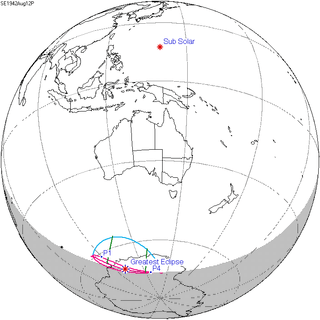 Partial |
120 | February 4, 1943 Total | |
| 125 | August 1, 1943 Annular |
130 | January 25, 1944 Total | |
| 135 | July 20, 1944 Annular |
140 | January 14, 1945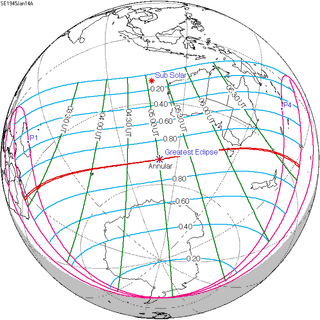 Annular | |
| 145 | July 9, 1945 Total |
150 | January 3, 1946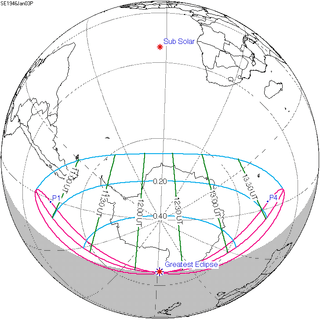 Partial | |
| 155 | June 29, 1946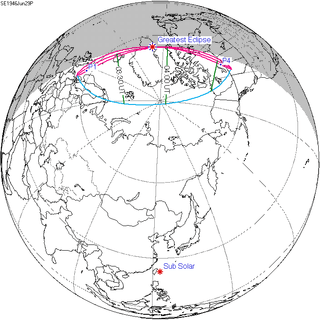 Partial | |||
Saros 145
This solar eclipse is a part of Saros cycle 145, repeating every 18 years, 11 days, containing 77 events. The series started with partial solar eclipse on January 4, 1639, and reached a first annular eclipse on June 6, 1891. It was a hybrid event on June 17, 1909, and total eclipses from June 29, 1927 through September 9, 2648. The series ends at member 77 as a partial eclipse on April 17, 3009. The longest eclipse will occur on June 25, 2522, with a maximum duration of totality of 7 minutes, 12 seconds. [1]
| Series members 16–26 occur between 1901 and 2100 | ||
|---|---|---|
| 16 | 17 | 18 |
 June 17, 1909 |
 June 29, 1927 |
 July 9, 1945 |
| 19 | 20 | 21 |
 July 20, 1963 |
 July 31, 1981 |
 August 11, 1999 |
| 22 | 23 | 24 |
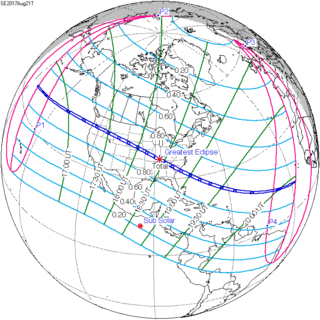 August 21, 2017 |
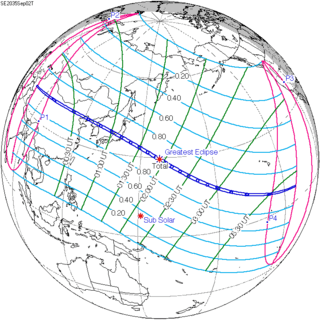 September 2, 2035 |
 September 12, 2053 |
| 25 | 26 | |
 September 23, 2071 |
 October 4, 2089 | |
Notes
- ↑ Espenak, Fred (Project & Website Manager), Statistics for Solar Eclipses of Saros 145, NASA, updated 2009 September 26.
References
- Earth visibility chart and eclipse statistics Eclipse Predictions by Fred Espenak, NASA/GSFC
- Solar eclipse of July 9, 1945 in the Soviet Union
| Wikimedia Commons has media related to Solar eclipse of 1945 July 9. |
